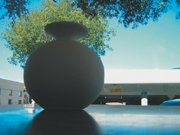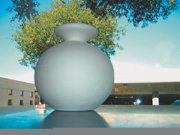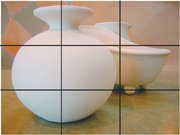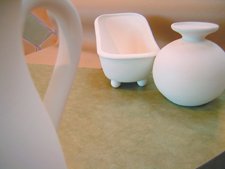Shooting Great Photographs
Take Lots of PhotosOne of the best qualities of a digital camera is that it takes photos instantlya 21st-century Polaroid Instamatic. You snap pictures pretty much the way you always have, but you can look immediately to see if the shot came out the way you hoped. And because no film or processing is needed, there's really no additional cost. Note There's no additional cost except for batteries, that is. Digital cameras chew up battery power, and that can get pricey. Some cameras can go through a custom battery pack in fewer than 100 shots. Keep this in mind as you compare your camera options, and consider rechargeables as an option. Taking lots of shots gives you the opportunity to work the way professionals do. It used to be that you'd take one shot of something and hope it worked. But now you can shoot 1, 10, even 50 shots if it's important that you get that perfect snapshot. And like a professional, you can peruse all the pictures you took, throw out most of them, and keep the cream. Without changing anything about your photographic abilities, this technique alone will improve your photo collection. Read Your Camera ManualIt wouldn't be possible for this book to describe the specifics of how your model of digital camera works. Suffice it to say it has a shutter release button (the "snap button"), some automatic and preset exposure controls, and an LCD screen for viewing images. It also has a jack under a flap somewhere that lets you connect the camera to your Mac's USB port with a cable, which usually is included with the camera. Spend some time with the manual that came with your camera to familiarize yourself with the basics of shooting and exposure. Get the Exposure RightAutofocus and autoexposure technologies are pretty advanced, and taking pictures in automatic mode will often produce the best all-around imagesbut not always. You, the photographer, can do some things to help yourselfand your picturesout. If you take a moment to look at your results as you shoot, you can make changes that help you get the right shot. As a rule of thumb, keep light behind you (not your subject) when you're shooting. Backlit subjects can be interesting once in a while (that hip silhouette look is very arty), but you'll probably miss the details you want in your subject. There's a fair amount of light in Jennifer's ceramics studioit comes from skylights, from spot and task lighting that points at the tables, and through the front window as ambient light. Shooting photos in the studio can be tricky because if you point the camera toward the front door, anyone you're shooting is going to have the bright daylight from the window behind him or her. If you can't get the light behind you, and you don't want a silhouette, your only option is to force your camera to flash even though it thinks there's enough light (after all, it sees plenty of light). A flash used in this way is known as a fill flash. Any flash should be considered a last resort in photographytry instead to get a more naturalistic look through proper exposure. Backlit subject Backlit subject with fill flash As your skill and comfort expand, you'll be using more manual controls (like the fill flash). Create Interesting Photographs Through CompositionOften, the only difference between boring photos and stunning ones is the way you frame your subjectwhat photographers call composition. When composing your photos, consider not always centering your subject, a technique that can make your photos more appealing and dynamic. You also may want to move in closer than you normally would, cutting out space around your subject to keep your viewers' attention. This technique often reveals more detail and emotion as well. Note Cameras autofocus by looking at an object placed in the center of the frame. (Your camera may have a little box or set of marks in its view to indicate this center region.) Problem is, this predisposes you to put the object you're shooting right in the middle. Some cameras allow you to offset your frame once the camera has taken a focus reading. If your camera has this feature, you can push a button to lock in the focus, then move your view slightly before taking the picture. To create dynamic composition in your photos, this capability is important. It can be tempting to photograph subjects in rigorous, rather clinical ways. If I say, "Take a photo of these three objects," many people will line them up and shoot them, from eye level, getting all three of the objects completely in frame. A rather dull composition This kind of photo has its place and, once in a while, mixed in with other dynamic snapshots, is fun and important. Still, many people's scrapbook snapshots are always framed like this and are just about this interesting: everyone lined up, looking at the camera, pausing from whatever they were doing for a photo. Giving your subject the freedom to move naturally while you take candid snapshots is important. Composing scenes with some people close to you and others slightly obscured will allow for more naturalistic photos. Slightly better composition Once you're comfortable with a more relaxed style, try changing your vantage point. Taking shots from different angles, including from above and below, is another key to creating interesting photos. Too many pictures are shot from the photographer's point of view, just standing around with camera to her eye. Using a camera with a flip-out screen (which today's camcorders tend to have) allows a wider range of positions, from holding it over your head to setting it at ground level, without having to keep your head behind the camera. Low angle (left), high angle (right) Also, try moving closer to your subject, allowing the camera to see only a part of the object or person you're shooting. Letting the camera do some initial cropping like this is a great compositional tool. When you're photographing someone's face and want a very close shot, it doesn't look unusual even if you crop off the top of the head a littlethe eyes are the important part. Tight shot, cropped in the camera Tip Every one of these guidelines applies to both still photography and video. As you get into video, keep these shooting rules handythey'll dramatically improve the photography in your videos. Getting closer to subjects and cropping tightly as you frame a shot can be effective in giving your snapshots a professional look. An important rule of composition, the "rule of thirds," says, in effect, don't put your subjects in the center of the frame, but rather put them a little off center (up or down, left or right). When you frame a snapshot, mentally create a grid of thirds across the screen, making sure your primary subject is located along one of the imaginary lines. Similarly, feel free to leave objects in the foreground of your shots, probably out of focus, and use them to frame the rest of your image (while still using that rule of thirds). Foreground objects (window frames, door frames, people in profile, and so on) do not need to be immediately recognizable to add to the composition of the frame. Finally, think about the background behind your subjects: You don't want it to compete with the subject too much. If it is visually "busy" or does not contrast with the subject enough, it can dilute the impact of your image. Ideally, the background will be simple and will have some basic contrast with the foreground object. Summary Tips
|
EAN: 2147483647
Pages: 142












